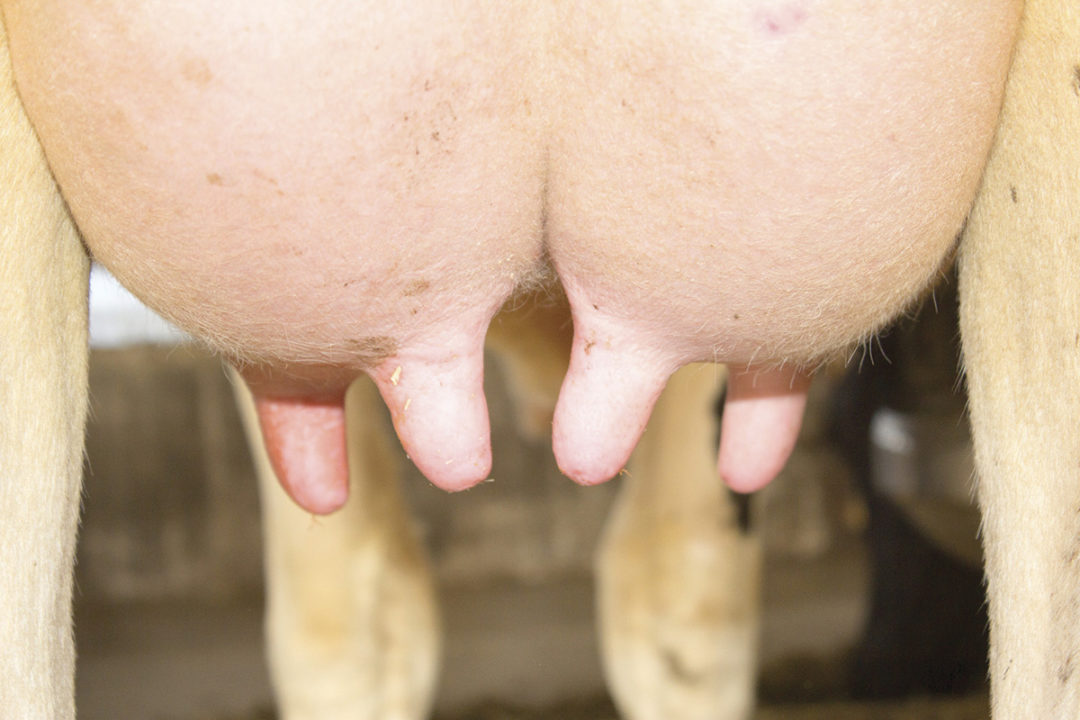Genetic selection strategies in dairy cattle breeding change over time, but the goal remains the same: breeding for more efficient and profitable animals. The success of selection for milk production has been well documented, with average milk yields per cow more than doubling in the past 60 years.
Because of the antagonistic relationship between yield traits and functional traits like fertility and health, heavy emphasis on milk production caused unfavorable genetic trends in other areas, resulting in cows that had more health challenges and left the herd earlier. This was addressed in the 1990s through the introduction of the Productive Life (PL) trait, allowing for the selection of cows that remained in the herd longer, and the Somatic Cell Score (SCS) trait, allowing for the selection of cows with lower somatic cell counts in their milk. SCS was used as an indicator of mastitis because it was an objective measure that was already available through the national milk recording system. This was the primary selection criteria in preventing mastitis for more than 20 years after its introduction.
In April of 2018, the Council on Dairy Cattle Breeding (CDCB) released genetic evaluations for resistance to six diseases, including mastitis, providing a more direct method of selection for improved udder health than using SCS alone.
The data pipeline
Genetic improvement of any trait relies on the collection of measurable phenotypes. For most traits in U.S. national evaluations, the pipeline of data has existed for decades through milk recording with the Dairy Herd Improvement Association (DHIA), and data points such as milk yield, somatic cell counts of milk samples, and breeding and calving dates.
The foundation of mastitis resistance evaluations relies on event data voluntarily recorded and reported by producers from on-farm management software. This information is then standardized at Dairy Records Processing Centers (DRPCs), to create a centralized system of capturing health data at a national level.
Among the health traits evaluated by CDCB, mastitis has the highest incidence rate on farms, and the mastitis-resistance predicted transmitting ability (PTA) has the highest heritability. This means relative to the other diseases, mastitis resistance is well-suited to improvement through genetic selection.
How to interpret
First introduced for Holsteins, the mastitis resistance trait is expressed as percentage points of resistance to mastitis above or below the breed average. If comparing the PTAs of two sires, the difference between their PTAs shows the difference in mastitis incidence in their daughters. Because the trait is expressed as resistance, larger values are more desirable, and selection of parents with higher PTAs should result in offspring that are more resistant and therefore less likely to be affected by mastitis events. In the December 2022 official CDCB evaluations, mastitis resistance evaluations were available for Holsteins, Jerseys and Brown Swiss.
Sire selection
Looking at the December 2022 Active A.I. file, PTA values for mastitis resistance of readily available Holstein sires ranged from +6.7 to -4.8, and the average was +1.2. For a herd with a mastitis incidence rate of 20%, we’d expect the daughters of the highest bull to have a mastitis incidence rate of 13.3%. Likewise, we’d expect daughters of the lowest bull to have a mastitis incidence rate of 24.8%. An 11.5 percentage point difference in mastitis incidence is substantial and will have noticeable impact on the profitability of these bulls’ daughters. Even within the top-100 Lifetime Net Merit (NM$) G status bulls, there is a 7.3 percentage point difference in mastitis incidence rate between the PTAs of the highest and lowest bulls. This shows that big differences in mastitis resistance capabilities can exist even among the highest-ranking NM$ bulls.
For Jersey bulls, the range in PTA for mastitis resistance was +3.7 to -5.6, with an average of -0.9, which is a smaller range and lower average than seen in Holstein sires. Because there is a smaller range, the expected observed difference in mastitis resistance (and therefore mastitis incidence) in daughters of the bulls with the highest and lowest PTAs would also be smaller. However, there are significantly fewer available Jersey sires with positive PTAs.
For Brown Swiss bulls, there is a much smaller sample size of A.I. sires and a relatively small range between sires with the highest (+1.7) and lowest (-2.0) PTAs for mastitis resistance. The average PTA among all Brown Swiss bulls is near 0.
Cow resiliency
Strategic breeding practices, such as the utilization of sexed semen and use of beef sires on dairy cows, have expanded over recent years and resulted in more consideration around how many replacement heifers are needed for a herd and which females they should be created from. Coupled with shrinking national heifer inventories, most herds will react with reduced turnover rates, which means milking older cows. This offers advantages but comes with challenges as well. A cow may not reach her peak potential for milk production until her fourth lactation, so by shifting to an older herd, producers can maximize pounds of milk produced. However, as cows get older, they also become more susceptible to culling factors, like disease or death. This is demonstrated in Table 1, using data from Holstein cows in herds enrolled in DHIA testing that left the milking herd in 2021.

To combat this, we can select for increased mastitis resistance and strive toward creating a resilient cow that remains a healthy, productive member of the herd lactation after lactation. Because mature cows should also be producing the highest volume of milk compared to their younger herdmates, extending their herd life can make major contributions to a farm’s bottom line.
Thinking about the future
Current genetic selection approaches in dairy cattle breeding involve selecting for a balance of economically important traits, and there will be a continued trend of newly introduced traits that affect functionality and efficiency. Early embracing of these traits, both by breeding companies in the development of A.I. sires and producers in development of replacement heifers, will result in favorable genetic progress. It is important to remember that the basis of any genetic evaluation is a pipeline of measurable phenotypes that can be recorded and standardized. Producers currently participating in national milk recording through DHIA who are not already recording health events in their on-farm software are encouraged to do so to continue providing data to improve the quality of the evaluations for the industry.







